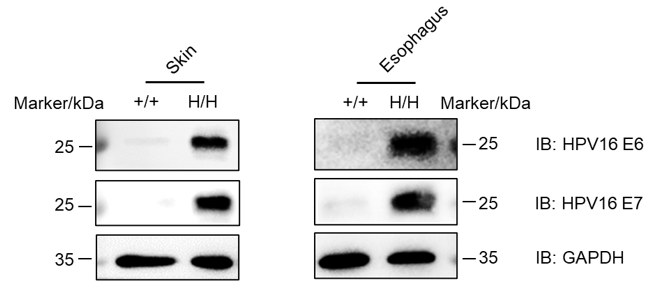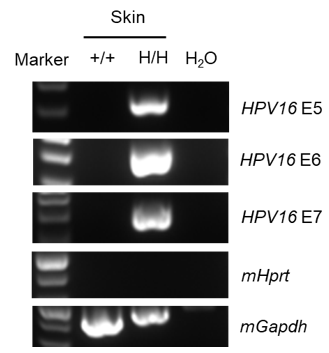B-H11-hINV-(HPV16 E6/E7/E5)x2 mice(FVB)
| Strain Name |
FVB-Igs2tm1(IVL-HPV16E6/E7/E5, IVL-HPV16E6/E7/E5)Bcgen/Bcgen
|
Common Name | B-H11-hINV-(HPV16 E6/E7/E5)x2 mice(FVB) |
| Background | FVB | Catalog number | 113053 |
|
Aliases |
HpV16gp1; HpV16gp2, HpV16gp6 |
||
|
NCBI Gene ID |
1489078, 1489079, 1489077 | ||
- Human papilloma viruses (HPVs) can be classified as either high risk or low risk according to their association with cancer. HPV16 and HPV18 are the most common of the high risk group while HPV6 and HPV11 are among the low risk types. Approximately 90% of cervical cancers contain HPV DNA of the high risk types.
- Mutational analysis has shown that the E6 and E7 genes of the high risk HPVs are necessary and sufficient for HPV transforming function. The specific interactions of the E6 and E7 proteins with p53 and pRB, respectively, correlate with HPV high and low risk classifications. The high risk HPV E7 proteins bind to pRB with a higher affinity than do the low risk HPV proteins, and only the high risk HPV E6 proteins form detectable complexes with p53 in vitro.
- HPV16 E5 is an 83–amino acid membrane-associated protein that is found in detectable levels in the Golgi apparatus, endoplasmic reticulum, and nuclear membrane. HPV16 E5 is considered an oncogene because in tissue culture it transforms murine fibroblasts and keratinocytes.
Targeting strategy
Gene targeting strategy for B-H11-hINV-(HPV16 E6/E7/E5)x2 mice(FVB). A chimeric CDS of human HPV16 E6/E7/E5 are inserted into mouse Hipp11 (H11) locus in B-hINV-HPV16 E6/E7/E5 mice. The chimeric HPV16 E6/E7/E5 protein expression will be driven by human hINV promotor.
Protein expression analysis

Western blot analysis of HPV16 E6/E7 protein expression in homozygous B-H11-hINV-(HPV16 E6/E7/E5)x2 mice(FVB). Various tissue lysates were collected from wild-type FVB mice (+/+) and homozygous B-H11-hINV-(HPV16 E6/E7/E5)x2 mice(FVB) (H/H), and then analyzed by western blot with anti-HPV16 E6 antibody (Santa cruz, sc-460) and anti-HPV16 E7 antibody (Santa cruz, sc-65711). 40 μg total proteins were loaded for western blotting analysis. HPV16 E6 and E7 was detected in skin and esophagus in homozygous B-H11-hINV-(HPV16 E6/E7/E5)x2 mice(FVB).

Strain specific analysis of HPV16 E6/E7/E5 mRNA expression in wild-type FVB mice and B-H11-hINV-(HPV16 E6/E7/E5)x2 mice(FVB) by RT-PCR. Skin RNA were isolated from wild-type FVB mice (+/+) and homozygous B-H11-hINV-(HPV16 E6/E7/E5)x2 mice(FVB) (H/H). Human HPV16 E6/E7/E5 mRNA was detectable only in homozygous B-H11-hINV-(HPV16 E6/E7/E5)x2 mice(FVB) but not in wild-type mice.









